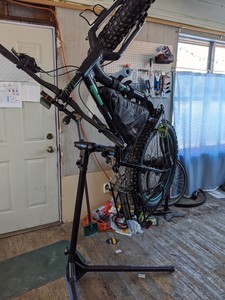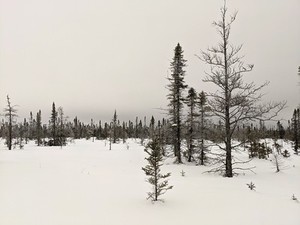 Actif Epica is the third and final race of the Order of the Hrimthurs. After completing Tuscobia and Arrowhead, I was feeling tired but strong. In reviewing the route, I had some concerns about resupply points, but after some research, I found that opportunities for food and water were spaced about 16 miles apart. With my hydration pack holding over five hours’ worth of liquid fuel, I felt confident that even if the convenience store in Saint Malo was closed, I’d be fine.
Actif Epica is the third and final race of the Order of the Hrimthurs. After completing Tuscobia and Arrowhead, I was feeling tired but strong. In reviewing the route, I had some concerns about resupply points, but after some research, I found that opportunities for food and water were spaced about 16 miles apart. With my hydration pack holding over five hours’ worth of liquid fuel, I felt confident that even if the convenience store in Saint Malo was closed, I’d be fine.
This year’s course was a 115k loop, with the 230k bike route repeating the loop a second time. Knowing how I feel about repeating sections of a course, I opted for the one 115k loop to meet the requirement for the Order of the Hrimthurs. It was the best way for me to finish strong and motivated.
Rolling Out
At 8:00 AM Saturday, everyone in my category gathered in the parking lot of the Sugar Shack in Saint Pierre-Jolys, ready to roll out along the Historic Crow Wing Trail beside the Rat River. The first several miles were a mix of snow-covered gravel, followed by a stretch of proper gravel road, before leading back onto the Crow Wing—a narrow walking path through deep snow. I considered lowering my tire pressure to ride through, but knowing I’d be back on gravel and later hitting ice, I opted to keep my pressure higher and enjoy a brisk hike through the woods instead.
Actif Epica is known for throwing a mix of conditions at racers, and this year was no exception. The route ranged from hard pavement in the north to a frozen lake crossing in the south. At any moment, windblown snow could turn a once-rideable section into a slow trudge. Field crossings became a strategic game, with racers opting to bypass the blown-over Crow Wing trail in favor of older, firmer snowdrifts just 10 meters over—even those had patches of soft snow lurking beneath.
Bonus Miles and Confusion
 As I approached the southern turnaround near Saint Malo, I noticed a left turn that wasn’t listed on the cue sheet but appeared clearly on my GPX track. Trusting my track, I followed the turn, only to realize later that the next cue sheet direction made no sense for reaching the checkpoint. I doubled back and, when I reached the turn I missed, I couldn't believe I didn't see the "TURN RIGHT" cue on my GPS. My mistake added 8.2 bonus kilometers of hiking and biking to my total.
As I approached the southern turnaround near Saint Malo, I noticed a left turn that wasn’t listed on the cue sheet but appeared clearly on my GPX track. Trusting my track, I followed the turn, only to realize later that the next cue sheet direction made no sense for reaching the checkpoint. I doubled back and, when I reached the turn I missed, I couldn't believe I didn't see the "TURN RIGHT" cue on my GPS. My mistake added 8.2 bonus kilometers of hiking and biking to my total.
Arriving in Saint Malo, I searched for the QR code mentioned on the website to confirm my checkpoint visit but found nothing. There was also supposed to be a bag of physical tokens for foot racers to take to prove their visit, but I was sure that system didn't apply to cyclists, and I didn't see the bag anyway. To be safe, I stopped at the CO-OP Gas Bar and made a purchase, securing a Randonneur-style receipt as proof of passage.
Northbound and Into the Cold
 On my third time through a deep-snow hiking section, I started looking forward to the return trip through the shallower-snow walking section from the morning. Rolling back through Saint Pierre-Jolys, I was tempted by two things: biking on the ice skating track in the park and stopping at the boulangerie for fresh bread. Since stopping isn't racing, I kept moving toward the checkpoint, where I refilled my hydration pack and explained my checkpoint detour. As soon as I pulled out my receipt, the volunteers reassured me—if I had a receipt, they’d trust I was telling the truth.
On my third time through a deep-snow hiking section, I started looking forward to the return trip through the shallower-snow walking section from the morning. Rolling back through Saint Pierre-Jolys, I was tempted by two things: biking on the ice skating track in the park and stopping at the boulangerie for fresh bread. Since stopping isn't racing, I kept moving toward the checkpoint, where I refilled my hydration pack and explained my checkpoint detour. As soon as I pulled out my receipt, the volunteers reassured me—if I had a receipt, they’d trust I was telling the truth.
The northern section proved to be the easiest, with long stretches of gravel roads and farm tracks with minimal snow. I reached Niverville just before sunset as the temperature continued dropping. My balaclava and neck gaiter had frozen solid, but the kind folks at the curling club had the heat cranked up. I took advantage of the warmth to dry them out on a vent while enjoying the traditionally fantastic and unexpectedly Costco-store-brand perogies.
One of the unusual elements of this particular winter ultra was the road crossing at a traffic light in Niverville. Compared to the remoteness of Tuscobia and Arrowhead, it felt strange to be stopping for urban traffic and a crosswalk light and I was happy to get back onto gravel roads as quickly as possible.
The Final Push
 With the sun setting, I double-checked my lights. My Sinewave Beacon headlight, usually powered by my dynamo hub, was running off a tiny USB battery bank—a donor prize from the MS150 last summer. I was impressed at how well it held up in the cold. Running off a battery unlocked the Beacon's hidden option of blinking mode, which was required for racer safety.
With the sun setting, I double-checked my lights. My Sinewave Beacon headlight, usually powered by my dynamo hub, was running off a tiny USB battery bank—a donor prize from the MS150 last summer. I was impressed at how well it held up in the cold. Running off a battery unlocked the Beacon's hidden option of blinking mode, which was required for racer safety.
The fading daylight turned into full darkness, and the landscape became a quiet expanse of blown snow, distant lights, and a clear sky. A quick stop at Black Earth Grills on the Crystal Spring Colony for the final checkpoint was later revealed as an opportunity missed when I found out they had grilled some ribs, but I hadn’t spotted them at the time.
The final stretch started on the same route I’d ridden back in 2020. Through the parking lot, out the south side into the woods, and down to the Rat River before diverging from the 2020 route in a short climb back onto gravel. I’d seen where the trail rejoined on my way north earlier, so I could feel I was almost done. In the darkness and cold, I passed a couple of southbound cyclists and exchanged a wave with a runner heading north. Everything felt familiar now, moving quickly past the railroad tracks, through the tiny town of Otterburne, and over the Rat River twice before hitting Rat River Road and the final approach to the Sugar Shack.
Finishing & Reflection
Crossing the finish line, I was greeted with mild applause before collecting both my finisher’s trophy and my Order of the Hrimthurs trophy. I paused for a photo, my balaclava and neck gaiter frozen stiff and requiring some effort to remove. The warm soup and buttered rolls at the finish line were a welcome contrast to the icy sports drinks and Sour Patch Kids that had fueled me throughout the day.
Earning the Order of the Hrimthurs felt like a culmination of months of preparation, endurance, sheer determination. Each race had challenged me in different ways, and Actif Epica—true to form—delivered a final test of navigation, patience, and adaptability.
Now is the time to recover, reflect, and maybe finally enjoy a proper boulangerie stop.

 This year’s Arrowhead started a little warmer than last time; 60-70˚ warmer than last time, in fact. My first arrowhead was 30-40 below zero and this one started right around freezing.
This year’s Arrowhead started a little warmer than last time; 60-70˚ warmer than last time, in fact. My first arrowhead was 30-40 below zero and this one started right around freezing.
I had high hopes for this attempt. After working with a nutritionist a couple years ago, I honestly don’t know how I got through the first time except for sheer willpower. This time, I had a nutrition and hydration plan and, while I wasn’t 100% successful at executing it due to uneven surfaces, it was good enough to keep me going.
Leg 1: Start to Gateway
The snow was soft at the start and the racers ahead of me had created the usual rut in the trail, which was much faster to ride in but my skill level for following a track only twice the width of my tire is not high. I did my best to stay in the track but my front tire regularly hit the edge and put me off balance. A few times I almost fell down and a couple times I did fall down. Letting some air out of my tires made it a little better because I could just roll over the edge but that reduced the gains of staying in the rut. I ended up finding a relatively firm but slightly slower section of trail off toward the right edge.
 A few miles in, three skiers cruised past the line of bikes. They provided hours of conversation at checkpoints and at any other opportunity.
A few miles in, three skiers cruised past the line of bikes. They provided hours of conversation at checkpoints and at any other opportunity.
I arrived at Gateway at 13:45. It wasn’t my best time, but my goal wasn’t speed, it was completion and I was still 45 minutes ahead of my first attempt. At Gateway, I refilled my hydration/food pack from their sink (not recommended). Ate a snickers, and departed in 23 minutes.
Leg 2: Gateway to Melgeorges
The snow started getting stiffer as the temperature dropped a bit, which was welcome. I kept my eyes on the faster racers’ tracks and let them find and create the firmest track for me.
The first real hill on the route is at 45.1 miles. When I say real hill, I don’t mean it’s long or high, I mean it’s steep. It’s like 50%+ grade steep. My bike was lighter this year than in the past, so it actually wasn’t that bad to climb, but it was only the first hill of many.
Later in the leg, in the last 5 or so miles to Melgeorges, are the hills I immediately began to refer to as the Asshole Hills. Out of the many hills in that section, here are only two that earn the moniker. I’d swear there were more on my first attempt but maybe that’s just trauma speaking. As you approach the crest of one of the hills, you get to see the actual crest of the hill appearing in the distance beyond what you thought was the crest of the hill, at least twice as far away. On the other hill, as you approach the crest, you find the trail turns left and continues upward, again at least twice as far.
As I continued to drink the sulphur-smelling water from Gateway, my gut started rejecting the idea of food and water. I wasn’t sure the cause, but maybe I should have been more careful about eating a whole Snickers and purchased a bottle of water instead of using their sink.
 I paused several times just to be where I was. I was surrounded by darkness, trees, and sky with my lone headlight illuminating the trail ahead. While staring at the stars, I heard a low wolf howl off to my left. When I ask myself why I do this, I remind myself this is why.
I paused several times just to be where I was. I was surrounded by darkness, trees, and sky with my lone headlight illuminating the trail ahead. While staring at the stars, I heard a low wolf howl off to my left. When I ask myself why I do this, I remind myself this is why.
I reached Melgeorges at 22:39, now about 50 minutes ahead of my first attempt, the gain mostly attributable to my spending less time at Gateway. A racer had dropped out of the race a few weeks earlier for logistical reasons and made their cabin reservation available. I split it with another racer, so I had a place to crash and reset. After a hot shower and a grilled cheese, I left a light on for my cabin-mate and hit the sack. As I closed my eyes to sleep, I saw an endless waterfall effect of fat tire tracks in the snow.
Leg 3: Gateway to Embark
I got up feeling tired but a bit refreshed in the morning, made a pot of bad coffee and drank a cup, got dressed, and checked out of the checkpoint at 06:39, 4.5 hours behind my 02:09 checkout in 2019 but after a good 5 hours of sleep. My gut was reset and I was ready to tackle the last half of the distance and the last three-quarters of the difficulty.
This leg is the hilliest of the route but it starts with several miles of flattish trail. I spent hours wondering if it wasn’t as bad as I remembered and then the hills started at 20 miles to Embark. Every hill was hike-a-bike up, then a short ride down to the next hill, and repeat seemingly indefinitely, serenaded by the squeal of my brakes.
The snow was warm and sticky. My pedals were full of packed-snow-ice and became slippery, causing me to fall a few times, my right clip lost a screw, causing me to fall once. The groomer came through and hid the soft snow under smooth soft snow, causing me to fall multiple times. I put my foot down on fresh groomed snow, which turned out to be a foot of soft snow, causing me to fall yet again. At some point, I broke the right side drop off of my handlebars, which would have been really problematic with flat bars but it just removed one hand position for me.
 Eventually, the hills mostly ended and the clever signs for Embark checkpoint started. Lots of rollers later, I arrived at Embark to a full minute of cowbell ringing as I slowly approached from the distance. The time was 19:01,still on pace at 4.5 hours later than in 2019.
Eventually, the hills mostly ended and the clever signs for Embark checkpoint started. Lots of rollers later, I arrived at Embark to a full minute of cowbell ringing as I slowly approached from the distance. The time was 19:01,still on pace at 4.5 hours later than in 2019.
A hot maple steamer and full hydration bladder later, I continued forward, repeating the mantra I learned the first time: “three rollers and one big hill, then it’s flat.”
Leg 4: Embark to Finish
I reached the bottom of Wakemup, the “one big hill,” and thought it didn’t look that bad, but I remembered it as a monumental climb with a turn in the middle. I braced myself and began the long climb up the one big hill. When I got to the top of the hill I thought “was that it?” I rode across the flat top of the hill then plummeted down the other side.
Only 20-ish miles remaining and mostly flat. Now that I wasn’t getting on and off my bike, I started to feel the saddle-soreness from two days of riding and my arms were sore from holding myself and my hydration pack upright on uneven snow. I really wanted that extra drop hand position to be able to shift my weight around but the break in my handlebar was right below the hood.
As I reached the finish line, I felt strong enough to keep going and, more importantly, strong enough to bike the final, small rise to the finish line. I crossed the line to the serenade of cowbells and clapping after 42 hours and 6 minutes. Next stop: Actif Epica.

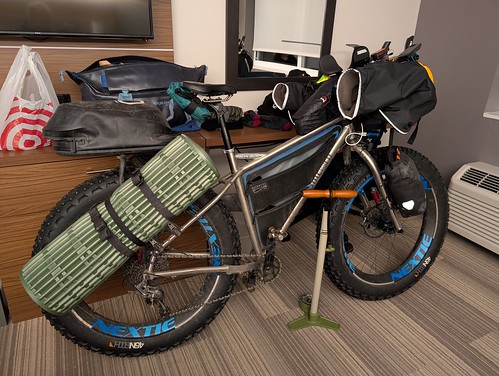
Several fellow riders asked if I was ok and this last time I said "you know what…no, I don't think I am." As the shock finally wore off, I felt dizzy and sat down in the grass alongside the road, notified the race directors I had likely broken my collarbone, and asked for a ride off the course.
To shorten a long story a bit, I ended up at the local hospital and verified I had broken my clavicle. A couple days later I found it had been broken in three places. Another week later I had surgery. Nearly two months later I was back on my bike and training.
This year, my goal remained the same but my motivation had increased. After 3 attempts at the 160 Bike category, I was determined to finish this year and start my 4th attempt at the Order of the Hrimthurs off with a success.
Prepping for the event, we all saw it was going to be warm and rainy again and there was snow on the trail. That meant the snow was going to be soft and slushy and, if it was deep, difficult to get through. There was also a good chance of rainwater on top of the ice on the lake.
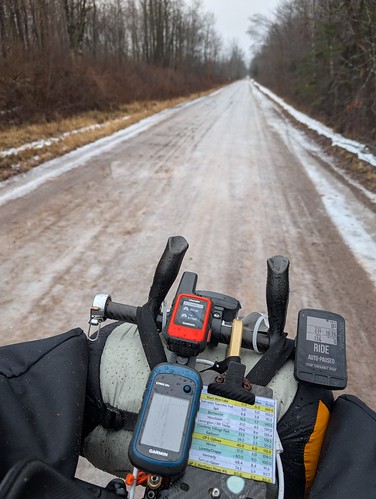 Starting the event, things seemed ok. Most of the snow had collapsed into ice and made for a pretty quick trail. I was a little nervous on the ice but got used to the surprising amount of grip provided by my studded tires. I had been training on Lake of the Isles so it wasn't unexpected, just welcome. The water on the trail was a problem, but not one I could do much about. After splashing through the first two or three puddles, my feet were soaked and would stay that way for the next 24 hours or so. Luckily, it wasn't cold or that would be a big problem.
Starting the event, things seemed ok. Most of the snow had collapsed into ice and made for a pretty quick trail. I was a little nervous on the ice but got used to the surprising amount of grip provided by my studded tires. I had been training on Lake of the Isles so it wasn't unexpected, just welcome. The water on the trail was a problem, but not one I could do much about. After splashing through the first two or three puddles, my feet were soaked and would stay that way for the next 24 hours or so. Luckily, it wasn't cold or that would be a big problem.
I made it to the first checkpoint at 45 miles about 10 minutes earlier than I had the year before. I was surprised and delighted to be going faster in moderately worse conditions. My wet socks felt like sponges as I walked around the chekcpoint, so I ringed them out without taking them off then I made the most of my short stop, filling my water bottles and eating a few Oreos, then headed out.
The trail east of the Ojibwa checkpoint was not as good. Starting around Draper, there was more snow on the trail and it increased as I went farther. Not unexpected but not great either. I let some air out of my tires to increase my grip on the slush and took my time getting to the end. Normally, this would be where the "type two" fun begins but I was honestly enjoying being on a trail that wasn't just a straight line with plenty of time to get to the other end.
There's a section of road and a section of what is usually groomed snowmobile trail between the Tuscobia trail and the turnaround checkpoint. The road was very wet, very fast, and a nice break from slush. The snowmobile trail was bushwhacking with hills followed by bushwhacking in a bog. I learned quickly to step where there's grass in the bog to get the least water pouring into my already soaked boots.
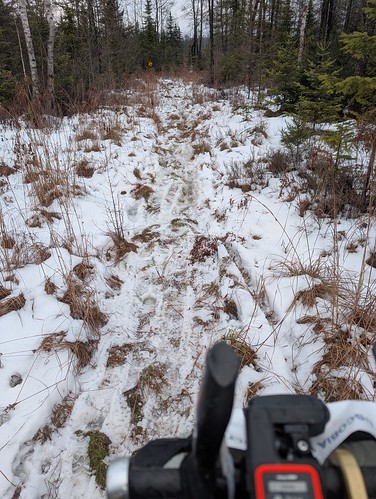 At the edge of the lake, the ice was broken up by a bunch of ultra racers crossing from the land to the ice. I opted to get off my bike and walk it over the broken ice, then had a challenge of getting back onto my bike as my boots slipped all over the place. Studded tires reliably have better tracktion than boots.
At the edge of the lake, the ice was broken up by a bunch of ultra racers crossing from the land to the ice. I opted to get off my bike and walk it over the broken ice, then had a challenge of getting back onto my bike as my boots slipped all over the place. Studded tires reliably have better tracktion than boots.
Biking across the lake was amazing. I even thought about getting into my aero bars but decided against it. The ice was fast and flat and it was always a little joy to find the next cone in the distance. The cones weren't actually there to mark our trail, they were there to tell us where to avoid ice fishing holes that hadn't frozen over in the warm night.
I rode across the broken ice on the other side and to the checkpoint. I wasn't thrilled about the idea of walking through a bog again but I had plenty of time to finish and knew I wouldn't be compeditive so there was nothing to worry about but filling up my water bottles again and preparing to take off. After a leisurely 17-minute stop and two grilled cheese sandwiches (I remembered the sandwiches from when I was sitting outside in a car with a broken collarbone), I rolled out and back across the lake.
The bog went past more quickly on the way back, as did the rest of the rough trail. The warmth and rain had melted more of the snow on the Tuscobia and I kept waiting for the really awful portion with deep ruts and slush and ice to show up but it never did. Did I imagine it or had it just melted that much? Either way, these 35 miles were easier but slightly slower than the same 35 miles the other way. I covered them in 9 minutes longer than I had the first time and arrived at the Ojibwa checkpoint on the return trip for the first time in my Tuscobia Winter Ultra experience.
Again, a 18-minutes stop this time compared to the 4-minute first one. I rung out my socks again and added vapor barrier socks and foot warmers because my feet were getting chilly in the now sub-freezing temperatures. More water in my bottles, another few Oreos, and I was on my way.
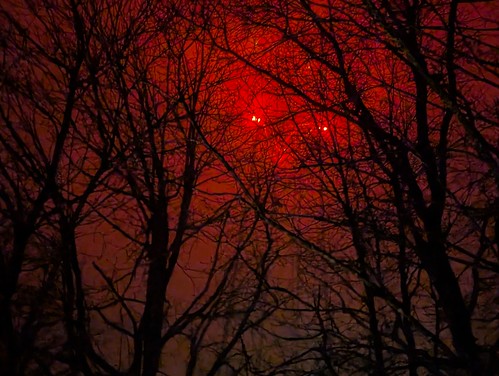 I was tired and slow for the last 45 miles. It was exceptionally foggy out and the air was wet and cold. The trip that took me 5 hours that morning took nearly 7 hours after 16 hours of biking. My legs were tired and stiff, but the trail was great and I enjoyed the murky beauty of the fog.
I was tired and slow for the last 45 miles. It was exceptionally foggy out and the air was wet and cold. The trip that took me 5 hours that morning took nearly 7 hours after 16 hours of biking. My legs were tired and stiff, but the trail was great and I enjoyed the murky beauty of the fog.
Finally, after 23 hours and 4 minutes of biking, I finished the Tuscobia Winter Ultra for the first time. I came in 7th place in the men's 160 bike category and 9th overall. Three or five slices of cold pizza at the finish line and I biked back to my hotel for a shower and a nap before breakfast.
Next time, if there is a next time (I always say "I don't need to do that again" after a long race, but I always know I'm going to want to do it again), I'll need to consider a few things:
How can I make eating easier on the back of a bike on a slippery surface? I probably wouldn't have been as tired and slow in the last 45 miles if I had been able to reliably keep getting my carbs in at a high enough rate.
How can I keep my feet dry? My 45Nrth Wölvhammer boots were either not waterproof or water was getting over the top. I need to re-waterproof them either way and maybe start with vapor barrier socks in already to see if that can keep water off my feet. I could also wear gators to try to keep water from going in the top of my boots when I hit a puddle. And I should put on fenders to keep at least some of that splashed water off my feet.
Pre-race training and nutrition
I worked with a nutritionist over 9 weeks this summer to help fuel these long rides. We dialed in a strategy that’s easy to manage with minimal thought that’s been extremely helpful in my training as well as in this race. Pro-tip: you can set custom alerts on your bike computer to remind you to drink and eat every x minutes of activity.
Day 1: The Familiar
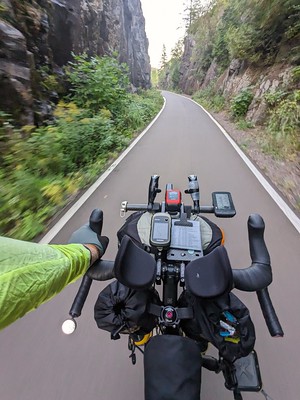
I’ve ridden the southern section of USBR 41 many times on training rides and both directions of the MS150 so not a lot stands out as novel to report here. I kept to my plan of 20oz of water with Skratch hydration plus my target grams carbs per hour, followed the twisty route around White Bear Lake, and onto the Sunrise Prairie trail, and made my first stop at the top of the hill in Pine City, after the roughest section of road on the southern half of the route. They’re slowly repaving and adding a trail but it’s going to take another decade.
I filled up my water bottles and added a lower concentration mix for the rest of the day, supplementing my liquid carbs with sour patch kids and buffalo blue cheese combos for some solid carbs and a little protein and fat to stay sated. I blew through Hinkley, which is a regular stop on this route for me when it’s hotter out but the temperature was perfect in the 10-15C range and I had plenty of fuel so no need to stop and rest or restock there.
The first few miles of the Munger trail are the most rutted, butt-bashing section of the trail and I was glad for my new suspension seatpost and my old suspension stem. Through the twisties after Finlayson and on to Moose Lake for another restock.
Carlton always seems farther than I think but it’s mostly downhill from Moose Lake to Duluth, including the amazing rock cut section on the final miles of the Munger trail. My plan had been to get to Duluth and see how I felt about continuing. Last time I stopped in Duluth but this time I was an hour earlier and feeling strong so another restock at the Kwik Trip and onward to Two Harbors.
The temperature dropped to -1C as the sun went down but I was feeling good and had enough layers. It was much nicer than the 30C+ temps dealt with on training rides this summer. The hills of the route just barely start on this section and I was reminded again how slow I am uphill. I knew if I pushed too hard I’d burn out and have trouble continuing so I kept to my target effort.
Brian caught up with me on the way into Two Harbors and we chatted for a bit. I was feeling the extra miles from Duluth and planning to stop at a hotel and they were planning to continue on. I got the second-to-last room in the hotel and the racer right behind me got the last one. We both paid too much but it was worth it for a shower and a soft bed. I forgot to hit the convenience store across the street before stripping off my bib and taking a shower and didn’t feel like wandering over in a towel so I had my recovery drink and ate some food I had with me for dinner and hit the sack at about midnight.
Day 2: Hills
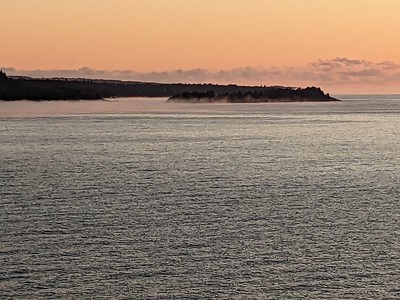
I stopped in Grand Marais about 3PM for a restock and booked a hotel room for the night. Even more expensive than Two Harbors but not unexpected. They mentioned another rider was going to get in around 11 that night; that was my plan too since I still wanted to hit the border before stopping. Nick was restocking on the way south and we chatted about their cascade of tire problems including sidewall tears and punctures. Never in my tens of thousands of miles of riding have I gotten a sidewall tear and it sounded awful.
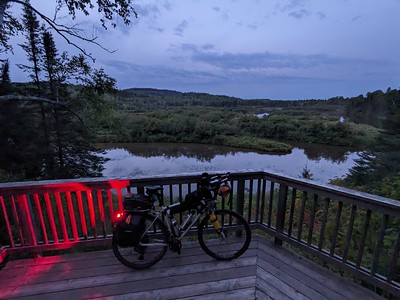
On the way back to Grand Marais, I thought it couldn’t be too far but then realized I was still on nice pavement so I wasn’t even 10 miles from the border.
3 miles from Grand Marais and I could see the lights ahead. I also saw a big spill of gravel out of the Ace Hardware parking lot. As soon as I hit the gravel I heard the pshht-pshht-pshht of a puncture, cursed, and stopped at the side. Turns out that conversation about sidewalls was just foreshadowing and I spent a good half hour in the rain draining sealant, sticking on a tire boot, inserting a tube, and swearing about the weird valve shape on the tube my tire gauge won’t seal with. I guessed at the pressure and continued on. When I arrived at my room, I pumped up my tire some more to get the bead to seat properly and eliminate the bump-bump-bump flat spot.
Day 3: More Hills
I had the impression that a place called The Hub would be a bike shop but I was wrong and didn’t buy a spare tube in case of another sidewall failure. Fingers crossed the first section southbound would be mostly identical to the first section northbound.
I spent most of the day thinking about where to stop for the night. I was well ahead of my previous race and if I stopped in Duluth, I felt like I’d be wasting my advantage against myself. But there didn’t seem to be any good options in Carlton or Moose Lake and I remembered one of my big problems last time was failing to stop on the 3rd night, so Duluth it is. I checked ahead online and found yet another overpriced hotel, this one with its own marina, and booked a room. The short day was good for me because the majority of the hills are between Grand Marais and Two Harbors and they were really tough after 400 miles of riding. The weather remained amazing in the mid 10s C without too much beating sun.
I arrived at my hotel late in the evening and was glad I didn’t try to go farther. I looked for decent delivery food for recovery and ordered a hawaiian pizza from toppers with some breadsticks. I didn’t realize pizza and crust could be that greasy. Eww. So I only managed ¼ of the pizza and a couple breadsticks and hoped it would be good enough. (I remembered when I got home there was a Pizza Luce in duluth.)
Day 4: The Final Miles
I was out the door by 5 AM which put me 5 hours behind last time but I knew how tired and slow I had been after riding all the way from Grand Portage that day and continuing on up the hill out of Duluth. So, continuing on up that hill out of Duluth, I stopped a couple times because it’s a long one with nice views. My first restock was at Moose Lake, which I got to later than last time (I thought) but I was feeling good.
The roughness of the last 5 miles of the Munger sucked, like they always do, but at this point, whatever…still glad for the suspension seatpost.
I skipped through Hinkley again and continued on to Pine City where last time I had to rest for a long while due to heat and exhaustion. Aside from some spiky pain in my calf due to sloppy left-leg pedaling and an overall lower available power than normal, I felt OK this time at 560 miles in. Even my saddle pain was pretty manageable, all things considered.
The section from Hugo to St. Paul feels amazing with what seems like more downhill than up. I knew once I got to the Gateway Trail I’d be even faster and the Vento would be faster still. I was probably slower on the Gateway this time than last because I had a burp flat on one of the bumps earlier this year that eventually earned me a new rim, which I wanted to avoid.
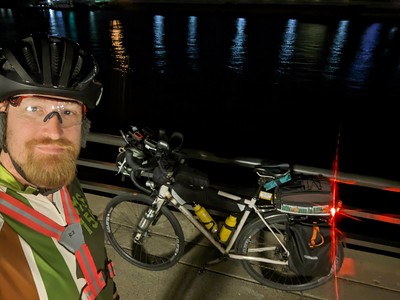
Lessons
Nailing down a hydration and nutrition plan really helped me. If I was better about evening recovery food and early morning pre-fuling I would have been able to shave more time off. Packing only the hydration/carb mix I intended to use, with only a little wiggle room, kept my weight low and significantly lower over time.
Packing lighter with smaller panniers was also a big help for the hills and the headwinds both ways on the North Shore.
Upgrading to an XX1 Eagle derailleur with a 10-50 cassette was great for me on the hills and the electronic shifting allowed me to spend way more time in the aero bars for comfort, efficiency, and speed.
My new gel gloves felt like cardboard after day 2, so I was glad I packed a spare set.
I focussed on building my base this year including several training rides this year close to 200 miles and I never felt like I was out of power, just getting really low. Now I need to continue building that base for the winter ultra season.
Gear
Specialized sequoia steel frame (steel is real)
Path Less Pedaled “PartyPace” and “SUP PLE” stickers (worth an extra 5 Watts)
Sun Deluxe dynamo hub
Sinewave Beacon headlight
Redshift shockstop stem and seatpost
Bisaddle adjustable saddle
Pirelli Cinturato Velo 35mm tires
SRAM Force/XX1 AXS 1x 10-50 drivetrain and Quarq power meter
Revelate feed bags and mag tank
Johnny D’s half frame bag and bits bundle
Baryak front aero/packing bars with sea-to-summit dry bag for sleep kit
Wahoo Elemnt Roam for ride tracking
Clipboard for cue sheet to major waypoints
Garmin InReach Mini satellite tracker for race tracking
Garmin eTrex 35 for navigation and back-up tracking
Garmin Enduro watch for heart rate monitor and back-up tracking
Ortlieb gravel-pack panniers
Skratch hydration mix, Skratch super-high-carb mix, Infinit :speed mix
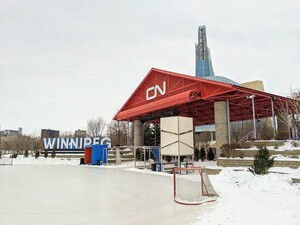 Actif Epica is the third and final race in the Hrimthurs series of winter ultras. At 205k on the prairies of Manitoba, it’s also the shortest and the flattest, which I thought would obviously make it the easiest. After failing the Tuscobia by not considering how checkpoint timing worked and scratching the Arrowhead by choice, I was expecting to bike for most of a day and then hang out in my hotel room for a while.
Actif Epica is the third and final race in the Hrimthurs series of winter ultras. At 205k on the prairies of Manitoba, it’s also the shortest and the flattest, which I thought would obviously make it the easiest. After failing the Tuscobia by not considering how checkpoint timing worked and scratching the Arrowhead by choice, I was expecting to bike for most of a day and then hang out in my hotel room for a while.
The gear requirements are similar for all three races, with variations around what temperature sleeping bag, how many lights, and how many emergency calories you need to bring. For this race, my packing list was very similar to others except I tried to lighten my load once again. I kept my sleeping gear the same as usual in a ready-to-use roll on my handlebars. I reduced the amount of solid food in my panniers and planned on mixing a new batch of liquid food at each checkpoint. And I kept my clothing options to what I considered “minimum safe” with enough changes of socks and hand warmers to stay warm and additional layers for the overnight low.
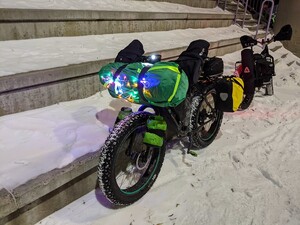 Saturday morning at the start of the race, it was -3°C (26°F) with no wind and a crisp layer of frost over everything. I was happy to be awake for a pre-dawn bike ride. I made one last check over my gear, filled up my hydration pack and put it on, and then heard a dribbling water sound from behind me. There was no bite valve on my hydration tube! What? No! That was my only plan for hydration. I didn’t even have a bottle packed, which was a bad plan now that I thought about it.
Saturday morning at the start of the race, it was -3°C (26°F) with no wind and a crisp layer of frost over everything. I was happy to be awake for a pre-dawn bike ride. I made one last check over my gear, filled up my hydration pack and put it on, and then heard a dribbling water sound from behind me. There was no bite valve on my hydration tube! What? No! That was my only plan for hydration. I didn’t even have a bottle packed, which was a bad plan now that I thought about it.
I knew exactly where it was, of course; sitting on the drying rack in the kitchen at home where I had taken it off and scrubbed it out and soaked it, trying to get rid of the gunk that’s a byproduct of not using only water.
I brainstormed possibilities and posted on facebook hoping someone would have a spare valve or tube. I was in luck! One of the racers had a whole pack they weren’t using. I headed over to the starting line early so I’d have time to get set up, thanked them profusely, and waited for 0600 to roll around.
Due to high water and broken ice on the trail, the first part of the route crossed a street and was intentionally slow, led by a pacer. Once we crossed at the stoplight and headed onto a narrow singletrack covered with deep, soft snow, the race began and group started to spread out with those who are good at riding a 3” path with 4” tires at the front and me getting closer to the rear with each foot I put down to stay upright. It was good to know there were others just as bad at this as I was though.
The Actif Epica is a unique race in this series, starting at The Forks in downtown Winnipeg and winding through residential areas, the University of Manitoba campus, and along a busy business street before reaching the flat, straight roads that divide the 1-mile squares of farm fields. In previous years, the race started at the US border and made its way north, but climate change has caused the conditions on the southern portion to be unpredictable and frequently impassable, so the race now starts and ends in Winnipeg.
As I made my way out of town, I was sort of adopted by a small group of riders at the back of the pack going about the same pace as me, including one guy who was acting as guide, but didn’t remember every change they made since last year, which was a lot of changes.
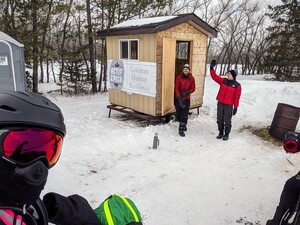 The first checkpoint was on a gravel road near the Red River Floodway and reminded me of an ice fishing house on stilts in a field...so maybe more like a deer stand but in a neighborhood. The trail under the bridge over the floodway was completely blown over with snow and very slow-going, but it cleared up on the other side and we were able to ride a bit before crossing over the levee and onto the road. We filled up our water, re-anchored one pack on a rear rack, and continued on after what, in retrospect, was probably too long a stop. The way back to the road on the blown-over trail seemed a little easier, but that was probably the fun-sized snickers bar I ate at the checkpoint talking.
The first checkpoint was on a gravel road near the Red River Floodway and reminded me of an ice fishing house on stilts in a field...so maybe more like a deer stand but in a neighborhood. The trail under the bridge over the floodway was completely blown over with snow and very slow-going, but it cleared up on the other side and we were able to ride a bit before crossing over the levee and onto the road. We filled up our water, re-anchored one pack on a rear rack, and continued on after what, in retrospect, was probably too long a stop. The way back to the road on the blown-over trail seemed a little easier, but that was probably the fun-sized snickers bar I ate at the checkpoint talking.
The checkpoint was only mile 20 of more than 125; the sun had been up for a while and the wind from the west was increasing dramatically. Riding east, I had no trouble keeping up with the group, but riding west I was struggling to keep moving, much less keep up, so I stopped trying in order to conserve my energy for the rest of the remaining century.
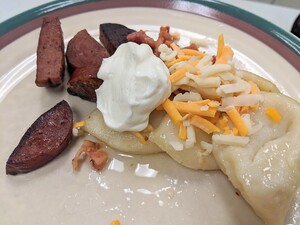 The checkpoints seemed really close, which I suppose they were, given there were 9 of them in 125 miles. The Niverville checkpoint stands out for me quite a bit. They had perogies that were locally made and delicious with bacon bits and sour cream. The park with the snow-covered trail just after Niverville also stands out for me since it was a bit harder to ride than the gravel. Between Niverville and Crystal Spring was some of the most variable trail conditions I’ve ever experienced. There was ice, hard snow, loose snow, rutted frozen dirt, pavement...it seemed like every time I got used to a surface it would change again, making it frustrating to repeatedly decide not to adjust my tire pressure.
The checkpoints seemed really close, which I suppose they were, given there were 9 of them in 125 miles. The Niverville checkpoint stands out for me quite a bit. They had perogies that were locally made and delicious with bacon bits and sour cream. The park with the snow-covered trail just after Niverville also stands out for me since it was a bit harder to ride than the gravel. Between Niverville and Crystal Spring was some of the most variable trail conditions I’ve ever experienced. There was ice, hard snow, loose snow, rutted frozen dirt, pavement...it seemed like every time I got used to a surface it would change again, making it frustrating to repeatedly decide not to adjust my tire pressure.
After Crystal Spring was the really interesting part, and I mean that in the most Minnesotan of all possible ways. Between Crystal Spring and St. Pierre-Jolys, the “trail” dropped down onto the Rat River. After taking a wrong turn on the way down because I followed the track with more bike tire prints (which is always the wrong choice because the wrong track always has twice as many tire prints from the people who took the wrong turn and came back again) I got onto a nicely plowed section of river and enjoyed the change of scenery and the shelter from the wind. But the plowed section disappeared quickly and the change of scenery morphed into “I’m literally going 100m right over there but the river winds so much I’m never going to get there” for turn after turn after turn. The snow quality was difficult to predict with some drifts being quite passable and others only being passable for a few feet before my cycling race became a foot race.
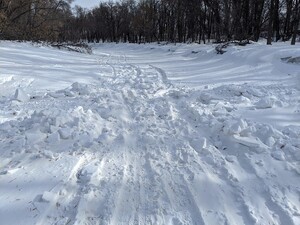 The time I spent walking on the river and pushing my bike was soul crushing. There were obvious tracks where other cyclists had just ridden through, probably because they were fast and light and only packed the required gear, keeping their bike even lighter. I am not and will probably never be one of those people, so I had to keep reminding myself that these events are events where I compete with myself, not anyone else. As only one person came the other direction, I was pretty sure I had been in last place for quite a while.
The time I spent walking on the river and pushing my bike was soul crushing. There were obvious tracks where other cyclists had just ridden through, probably because they were fast and light and only packed the required gear, keeping their bike even lighter. I am not and will probably never be one of those people, so I had to keep reminding myself that these events are events where I compete with myself, not anyone else. As only one person came the other direction, I was pretty sure I had been in last place for quite a while.
When I finally arrived at the end of the river section, I wasn’t sure if I was exiting in the right place because the “trail” up to the road at the bridge was easily a 150% grade for 12 feet or more. So add another trail surface to the list I guess? Time to climb off the bike and climb up the bluff using tire studs and brakes as a makeshift climbing axe.
At the turnaround checkpoint, there were a couple people just getting ready to leave, so I didn’t feel like I was too far behind everyone else. I took a little time to dry off my wicking layers and have some food and drink. I need to drink more while I’m actually riding, which is something I remind myself of at every checkpoint, which is clearly not often enough. I chatted with the folks at the checkpoint for a while, they gave me a commemorative pin, and I discovered I was running critically short on time to make the checkpoints on the way back before they closed. Once again, I was bitten by the fact the finish-line cutoff was timed for runners, not cyclists and that I need to really look at the timing of the last checkpoints when planning a race like this. So...out the door I went, leaving some unfinished ham and a lot of morale behind. Back down the paved road to the bluff, which I decided to ride down while riding my breaks and crossing my fingers. On the way back up the river, I kept trying to judge my distance by the quality of the snow I remembered. But I kept waiting for the really shitty snow to start and it kept not starting, meaning I had a really long way to go. But then my GPS told me to turn right off the river and cimb up to the road again, so something must have changed.
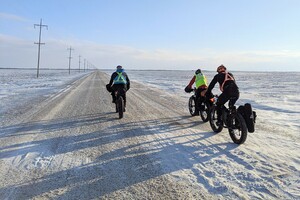 A likely explanation for the firmer snow is that I guess I hadn’t realized how much colder it was now than when I started. When I left St. Pierre-Jolys, it was -17ËšC and it was all the way down to -23 by the time I left the river. My tires were getting softer, my feet were getting colder, and my time was running out. There was another rider at Crystal Spring who was also feeling the cold. I tried to give as much of a pep talk as I could while changing my socks for dry ones for better insulation and cramming a sticky bun and some soup into my face.
A likely explanation for the firmer snow is that I guess I hadn’t realized how much colder it was now than when I started. When I left St. Pierre-Jolys, it was -17ËšC and it was all the way down to -23 by the time I left the river. My tires were getting softer, my feet were getting colder, and my time was running out. There was another rider at Crystal Spring who was also feeling the cold. I tried to give as much of a pep talk as I could while changing my socks for dry ones for better insulation and cramming a sticky bun and some soup into my face.
We ended up leaving at the same time but I was slightly faster down the road because I was so worried about time. The final checkpoint closed in a few hours and I had a very long way to go. It’s ok though, after we rode together for a while, I was going too slow for them to stay warm, so they passed me and finished an hour before I did.
Another big drain to my morale was a (surprisingly short at 2 miles) section of farm road that was completely impossible to ride due to footprints, soft snow drifts, and ice. I tried riding in the field next to it but that didn’t work either, so it was time to walk again. My bike computer says it took 45 minutes, but there were several times it didn’t think I was moving at all, so it was probably longer than that.
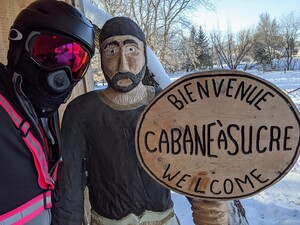 More pierogies at Niverville; more slow progress as the temperature continued to drop. After St. Adolphe, I had two concerned support drivers basically shepherding me in and giving me directions and encouragement all the way to the University. I wasn’t sure I’d make it before it was officially closed to the 205k bikers at 0300, which was just a couple hours away, but they kept telling me they wouldn’t turn me away because the checkpoint was open until 0430 for the runners. I still don’t understand how that works, but I arrived at the checkpoint at 0315, which I guess was good enough. 25 minutes later I was back out on the road and on my way to the finish. But I got kind of lost on the way out of the rec center and took a scenic tour of that block of the campus.
More pierogies at Niverville; more slow progress as the temperature continued to drop. After St. Adolphe, I had two concerned support drivers basically shepherding me in and giving me directions and encouragement all the way to the University. I wasn’t sure I’d make it before it was officially closed to the 205k bikers at 0300, which was just a couple hours away, but they kept telling me they wouldn’t turn me away because the checkpoint was open until 0430 for the runners. I still don’t understand how that works, but I arrived at the checkpoint at 0315, which I guess was good enough. 25 minutes later I was back out on the road and on my way to the finish. But I got kind of lost on the way out of the rec center and took a scenic tour of that block of the campus.
The last 15 miles or so were hard. So hard. The temperature had dropped from -3ËšC at the start to -30ËšC a few hours back and -27ËšC as I left the last checkpoint. I was bundled up for warmth, which slowed me down. My bearings and wheels were cold, which slowed me down (probably...that’s my excuse). I had been riding for almost 24 hours straight and a little faster than I should with a little less food than I should, which slowed me down. But, by the magic of foot race checkpoint timing. I had 5 hours to go the last 15 miles of city streets, so it didn’t really matter how slow I was. I could probably walk that if I had to.
I was met a couple more times by the support drivers and given more encouragement. From time to time on the roads, I could see a car or truck sitting by the side of the road ahead with its lights on making sure the racers were ok. I passed many runners between 10 and 5 miles from the end, another reminder that this was a foot and bike ultra, not just bike.
Cross a cool old bridge again. Ride through a park again. Slip around a bit less on the narrow singletrack again. Cross the street at a stoplight again. Finally arrive at the finish line under the CN amphitheater at The Forks at 0600.
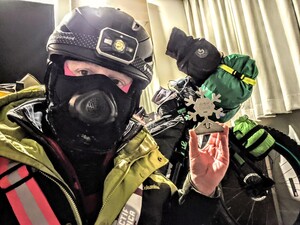 I walked my bike into the bunker under the stage, gave them my name, picked up my trophy, and biked back across the ice rink and the park to my hotel to take a hot shower/bath and sleep for as long as it took.
I walked my bike into the bunker under the stage, gave them my name, picked up my trophy, and biked back across the ice rink and the park to my hotel to take a hot shower/bath and sleep for as long as it took.
Overall, I guess it was a good effort. I finished in just under 24 hours for an average of 5mph including zeros, which is honestly not that bad for a single effort in winter.
As I keep doing these things, I keep learning things. The biggest thing I learn every time is I need to decrease my weight even more if I can. When I unpacked my bag, I had a couple pairs of socks and a hat and a bunch of food I didn’t touch. The food...I feel like I should have eaten that along the way, which is the next biggest thing I learn every time; the clothing and especially the hat...I’m still glad I had them because so many things could have gone wrong along the way and caused me to need them, which I learned on my first Arrowhead.
I’d post a gear list here, but it really was basically like every other gear list I’ve written. Most of the ride I was wearing a merino bottom base layer with my Naughtvind bib under wind pants, and a merino top base layer with a PI winter jersey and winter jacket.
See you next year!
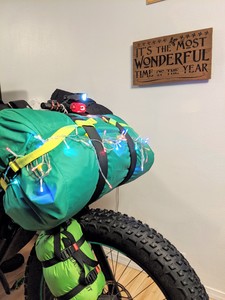 After the Tuscobia in December, you may recall I had some mild neuropathy; a slight numbness of the tips of my middle two fingers. I gave myself until January 19th, one week before the Arrowhead, for it to clear before making my decision on whether I was going to do the Arrowhead or not.
After the Tuscobia in December, you may recall I had some mild neuropathy; a slight numbness of the tips of my middle two fingers. I gave myself until January 19th, one week before the Arrowhead, for it to clear before making my decision on whether I was going to do the Arrowhead or not.
The week after Tuscobia, I took my Mukluk over to Paulie at Go Physio for a bike fit and to get some PT exercises for my fingers. Turns out at some point my saddle had wandered backward by almost 2cm, causing my position to change radically from my previous bike fit before the 2019 Arrowhead. A few other tweaks and a new stem later, and the bike should fit much better. I’m still considering extra padding and some custom parts to give me more cush and more hand positions inside my pogies.
On January 19th it had not gone away, which meant I was not racing the Arrowhead. Since I had failed to complete the Tuscobia, thereby botching my chance at an Order of the Hrimthurs this season, I at least had less incentive to go back on my earlier ultimatum.
As race day grew closer, the weather forecast looked more and more like the forecast we had for Tuscobia. The predicted high temperature kept increasing to just a few degrees below freezing and I was glad to not have to deal with that crap again.
But I already had a room booked and had paid the price of admission, so I decided to go north and at least pick up my t-shirt and goodie bag and have dinner with a bunch of bonkers people doing a bonkers thing.
Over the final week though, the forecast started trending cooler and looking much better. 20˚F with no rain seemed like nearly perfect conditions and I started itching to ride the trail. At the last moment, I decided to bring my bike and get out onto the trail the day before, then decide if I was going to be a DNF or DNS for this race. Since my fingertips were still numb, I wasn’t going to finish, but I might just start.
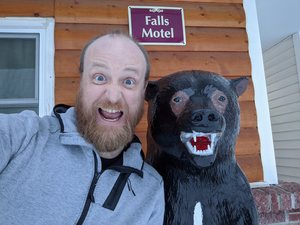 I arrived in International Falls to a balmy 26˚F, literally 72˚F warmer than the -46˚F the morning before the race last year. I was staying at the Falls Motel again, since it’s convenient to the starting line and reasonably affordable. My room was a little awkward for my bike, but at least it opened directly outside, so I didn’t have to deal with hallways or stairs, like I did at the Tuscobia.
I arrived in International Falls to a balmy 26˚F, literally 72˚F warmer than the -46˚F the morning before the race last year. I was staying at the Falls Motel again, since it’s convenient to the starting line and reasonably affordable. My room was a little awkward for my bike, but at least it opened directly outside, so I didn’t have to deal with hallways or stairs, like I did at the Tuscobia.
At gear check (and online), I was encouraged multiple times to at least start the race, if nothing else to keep the finishing rate low. Some folks wanted me to disregard my neuropathy and ride to the end anyway, but I like my fingers and I had already made plans to leave for Minneapolis Monday afternoon. At this point, my plan to ride to checkpoint one and then drop was pretty well solidified. I just couldn’t stay off this trail.
 Note: The goodie bag was totally worth the 5-hour drive to International Falls. A little food, a great (still confusing to me) ¾ length t-shirt, and a snazzy black duffle with the Arrowhead Ultra 135 logo on it, among other things. I was super chuffed at the tube of official Arrowhead Winter Ultra lip balm which was just in time since my previous one is running out.
Note: The goodie bag was totally worth the 5-hour drive to International Falls. A little food, a great (still confusing to me) ¾ length t-shirt, and a snazzy black duffle with the Arrowhead Ultra 135 logo on it, among other things. I was super chuffed at the tube of official Arrowhead Winter Ultra lip balm which was just in time since my previous one is running out.
Sunday, before the race, I went out for a quick, two-hour ride on the Blue Ox/Arrowhead Trail to test conditions and tire pressure. The trail was mostly hard and fast but difficult to read. There was a shelf on the right edge that looked perfectly smooth, but it had a thin crust over the top that sucked Watts as my tires broke through it, and there were snowmobile-churned sections that were even worse. Sometimes the snowmobile tracks had a narrow strip of hard, easy trail and sometimes the hard, easy section was actually on that crust-covered shelf. This reinforced one of the things I learned at Tuscobia: I’d have to ride back and forth on the trail a few times to find the best line and if I ever thought my line wasn’t the best, I’d have to do it again.
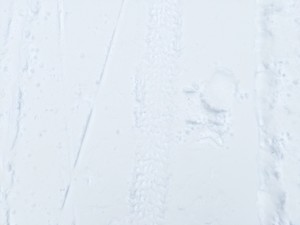 Throughout my test ride, there were times I thought I should increase my tire pressure to go faster and times I thought I should decrease my tire pressure for more stability. I don’t set my fat tire pressure by PSI anymore unless I just want to set it to 20 for fast commuting, and whatever pressure I was at seemed like a decent compromise. Several people asked what pressure I was running and my only honest answer was “I have no idea.”
Throughout my test ride, there were times I thought I should increase my tire pressure to go faster and times I thought I should decrease my tire pressure for more stability. I don’t set my fat tire pressure by PSI anymore unless I just want to set it to 20 for fast commuting, and whatever pressure I was at seemed like a decent compromise. Several people asked what pressure I was running and my only honest answer was “I have no idea.”
That night at dinner, I was chatting with a few other racers and realized that there is no support between the start and Gateway. Since that was as far as I was planning to ride, there was no difference between supported and unsupported. I checked with Race Director Ken and I had until the next morning to make a decision and announce it when I checked in at the starting line.
Turns out it was an easy decision to make. The choice was basically if I was going to bike to checkpoint one and drop there or if I was going to bike to checkpoint one looking like an unsupported Arrowhead badass and drop there. So when I checked in, I announced my intention to go unsupported and got the big orange “X” through my bib number that broadcasted my badassery to the world.
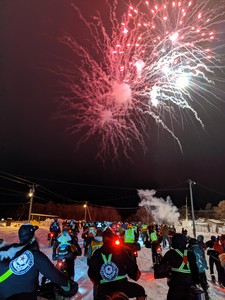 At 7:00 AM sharp(-ish) the fireworks went off and I got passed by most of the other riders while I put my phone away after taking pictures.
At 7:00 AM sharp(-ish) the fireworks went off and I got passed by most of the other riders while I put my phone away after taking pictures.
If anything, the trail was better this morning than yesterday. Since I am not a fast or strong rider and a I am a photographer I was well toward the back of the pack so the fat-tire-packed line was wide and solid. I averaged about 8 MPH up to the first turn where the Blue Ox and Arrowhead trails split at a small shelter. Last year, this was where I remembered I hadn’t eaten breakfast and pulled half-frozen chicken tenders out of my pocket. No need today, just a few small clothing adjustments and a photosphere and I was back on the trail.
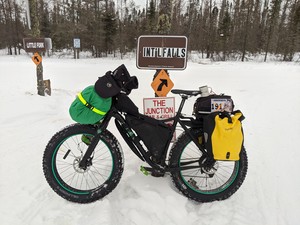 Thinking back to last year again, mile 13 was where everything started to get slow. The trail had more churn from snowmobiles and deeper snowdrifts causing me to lower my tire pressure to keep from washing out. This year, I couldn’t detect any change in the trail at all. Maybe it was my new Dillinger 5 tires having more float than my Dillinger 4s from last year. Maybe it was because my bike was packed much lighter. Maybe the trail just didn’t change. Whatever was causing it, I was glad for the continued speed and easy pedaling.
Thinking back to last year again, mile 13 was where everything started to get slow. The trail had more churn from snowmobiles and deeper snowdrifts causing me to lower my tire pressure to keep from washing out. This year, I couldn’t detect any change in the trail at all. Maybe it was my new Dillinger 5 tires having more float than my Dillinger 4s from last year. Maybe it was because my bike was packed much lighter. Maybe the trail just didn’t change. Whatever was causing it, I was glad for the continued speed and easy pedaling.
The trail stayed great all the way to the next shelter where there was, thankfully, an outhouse of sorts. Really, it was more of a box with a toilet seat inside. Looking down through the opening, there was a surprising amount of sunlight illuminating what could have been either snow or frozen toilet paper. I didn’t matter but I did consider the difference between peeing off the side of the trail and peeing under an elevated box was maybe not that significant.
My speed continued to stay high. I’m not sure I can trust the average reported by my Wahoo Elemnt Roam since it showed my max speed as 378.1 MPH, which seemed somewhat unlikely. I suspect there’s some interference between my Garmin InReach transmitting my information to space and my Wahoo trying to read GPS signals on a similar frequency.
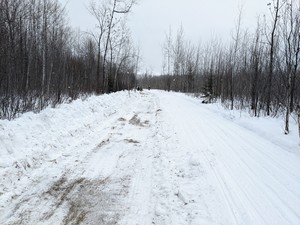 Judging by my speed though, it was somewhere around mile 31 where a construction crew had torn up half the trail to get their trucks through. That left the right-hand side for snowmobiles, which meant it was too chopped up to be stable for bikes. Where the trail had been plowed down to frozen dirt it was extra fast but where there were ruts and drifts it was extra sketchy. It was even more sketchy when a dozen snowmobiles were sitting “off the trail” in the plowed down section so they could all stare at some mechanical problem one of them had. I didn’t quite fall while moving over and I didn’t quite walk past them on the other side.
Judging by my speed though, it was somewhere around mile 31 where a construction crew had torn up half the trail to get their trucks through. That left the right-hand side for snowmobiles, which meant it was too chopped up to be stable for bikes. Where the trail had been plowed down to frozen dirt it was extra fast but where there were ruts and drifts it was extra sketchy. It was even more sketchy when a dozen snowmobiles were sitting “off the trail” in the plowed down section so they could all stare at some mechanical problem one of them had. I didn’t quite fall while moving over and I didn’t quite walk past them on the other side.
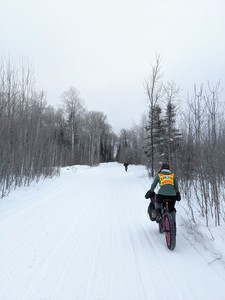 Once I got past the creek where a backhoe was installing new culvert, the trail returned to its prior awesomeness and my speed went back up. The hills just start to begin this side of checkpoint one, so I had a few fast descents and slow climbs. At one point, I must have hit a soft spot I wasn’t prepared for because I was suddenly under my bike on the side of the trail. Luckily, the waist-deep snow off the edge was very soft and the trees were very small. Any landing you can walk away from, right? Besides, it’s not an Arrowhead without a couple snow angels.
Once I got past the creek where a backhoe was installing new culvert, the trail returned to its prior awesomeness and my speed went back up. The hills just start to begin this side of checkpoint one, so I had a few fast descents and slow climbs. At one point, I must have hit a soft spot I wasn’t prepared for because I was suddenly under my bike on the side of the trail. Luckily, the waist-deep snow off the edge was very soft and the trees were very small. Any landing you can walk away from, right? Besides, it’s not an Arrowhead without a couple snow angels.
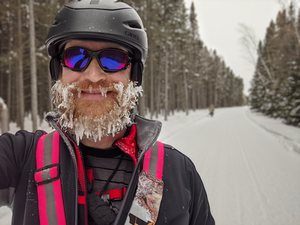 Just like last year, as I approached checkpoint one I wasn’t sure if I had somehow missed the turn. Even though I had a distinct mental image of what the turn looked like and no memory of passing anything like that, on a ride like this strange things happen. I needed to stop for a drink anyway, so I checked Google Maps. Less than a mile to go, of course.
Just like last year, as I approached checkpoint one I wasn’t sure if I had somehow missed the turn. Even though I had a distinct mental image of what the turn looked like and no memory of passing anything like that, on a ride like this strange things happen. I needed to stop for a drink anyway, so I checked Google Maps. Less than a mile to go, of course.
I sped down the hill to checkpoint one at Gateway General Store and called out my bib number to the volunteer checking people in. Normally, as an unsupported racer, I would just turn around here and head back to the trail once I knew my number was in the books for this checkpoint, but I was dropping, so I continued on to tell the next volunteer. They all gave me a hard time about quitting at 35 miles, but I had accomplished my goal for the day and was ready to stop. Oddly, I felt as though I could continue unsupported to the end even though I would need to melt snow for water and eat all the solid food I had with me because I hadn’t packed as though I would ride without support.
On the drive home, I was super hungry and thirsty. I really hadn’t managed my nutrition well for those 5 hours and I lost a lot of exhaled water to my epic ice beard. Next year, I’ll plan this better, and maybe I’ll take home one of the “toughest of the tough” trophies for an unsupported finish.
Things I learned:
- Packing lighter helps. Like it helps a lot.
- Cover your face even if its warm. You’ll save on hydration and reduce the risk of a migraine later on.
- It’s never too late to switch to unsupported.
After completing the Arrowhead 135 in 2019, as a rookie, with a bad knee, during a polar vortex, and loving the scenery and the accomplishment, I started considering the Order of Hrimthurs. “I’ve completed the hardest race of the three, in some of the worst possible conditions,” I thought, “so how hard could this be?”
Last summer, I signed up for the Tuscobia Winter Ultra 160-mile bike, The Arrowhead Winter Ultra 135-mile bike, and the Actif Epica Winter Ultra 200k bike, with the intention of finishing yet another impossible task on my first try.
So here’s how that went.
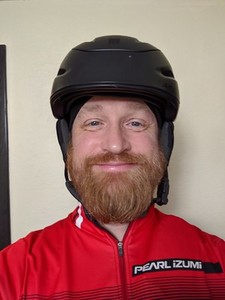 The weeks leading up to the Tuscobia, the weather looked grim; temperatures right around freezing with the possibility of precipitation. What’s so grim about that, you ask? Warm weather and snow sounds great, but soft trails and rain sounds terrible. Back when I used to winter camp as a boy scout, we were always glad when it was a few degrees below freezing and snowing instead of a few degrees above and raining because winter gear is rarely waterproof gear.
The weeks leading up to the Tuscobia, the weather looked grim; temperatures right around freezing with the possibility of precipitation. What’s so grim about that, you ask? Warm weather and snow sounds great, but soft trails and rain sounds terrible. Back when I used to winter camp as a boy scout, we were always glad when it was a few degrees below freezing and snowing instead of a few degrees above and raining because winter gear is rarely waterproof gear.
In 2018, the conditions were similar and the trail conditions were the subject of much talk from the participants. To add to the concern, the weather forecasts as the event grew closer kept predicting even warmer weather and an even greater chance of rain.
Despite the predicted conditions, I felt like I was reasonably well prepared. Waterproof outer layers, sufficiently wicking under layers, multiple changes of all my layers packed in my paniers, and an optimistic view of the relatively flat course ahead.
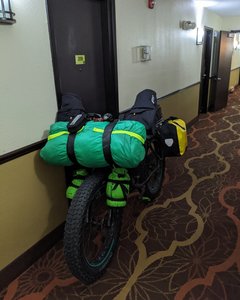 My hotel was about 3 miles from the starting line, and check-in was at 5:15 AM, so it was an early morning for me. It took only about 15 minutes to bike to the KoC hall to check in, but nobody was there for at least another 15 minutes. Not a big deal, but the lack of hot porridge did change my breakfast plans a bit.
My hotel was about 3 miles from the starting line, and check-in was at 5:15 AM, so it was an early morning for me. It took only about 15 minutes to bike to the KoC hall to check in, but nobody was there for at least another 15 minutes. Not a big deal, but the lack of hot porridge did change my breakfast plans a bit.
The race started promptly at 6:00 AM and we all set off down the Wild Rivers Trail toward the start of the Tuscobia Trail...and pretty much all of us at the back of the pack missed the turn and had to back-track at least a few feet. (We were a bunch of rookies.)
The first 18 miles of the trail were amazing. Hard, fast, flat, and scenic. I was really looking forward to a quick 160-mile ride and step one of three completed for the Order. Then we hit the town of Birchwood and everything changed.
The trail east of Birchwood was oddly softer and more churned-up by snowmobiles. Constant snowmobile traffic (we were warned they were not required to slow down when passing bicycles and there is no speed limit for snowmobiles in Wisconsin) kept breaking up the hard crust I was riding on and turning it into a soft, sloppy mess of half-baked mashed potato snow.
For folks who haven’t fat biked before, mashed potatoes is how we describe the worst snow for biking. It has this stick/slip thing going where you can be riding along fine and then your tires just move to the side, throwing you off balance. This is, however, what fat bikes were built for; the trick is just to lower your tire pressure until you start rolling over the top without it shifting under you. The downside is you lose a lot of speed.
After letting some air out of my tires, my average speed dropped from around 7 mph to around 5 mph. Not terrible, and it still gave me a reasonable finish time, but it was a solid kick in the morale.
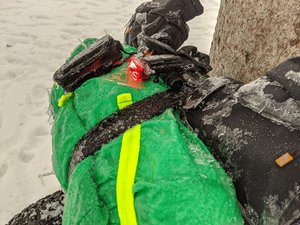 By the time I reached checkpoint 1 at Ojibwa, 30 miles and almost 5 hours later at 1:00 PM, it had been raining long enough and cold enough that my bike and all my gear was covered in a layer of ice that had broken and fallen off more than once. My outer layers were soaked through but I had dressed right and my base layers were mostly dry and I was in no risk of getting too cold.
By the time I reached checkpoint 1 at Ojibwa, 30 miles and almost 5 hours later at 1:00 PM, it had been raining long enough and cold enough that my bike and all my gear was covered in a layer of ice that had broken and fallen off more than once. My outer layers were soaked through but I had dressed right and my base layers were mostly dry and I was in no risk of getting too cold.
Continuing down the trail after spending too long trying to dry my gear and refuel, the conditions kept deteriorating. It took me far too long to figure out that the left side of the trail was faster since the 80-mile crew had set out that morning and kept to their right, meaning all the snowmobile traffic passing them had torn up my right side of the trail, making it nearly impassible. This is about when the winner of the 160, Neil, passed me going the other way so fast I barely had time to wave as he called out “hey yo!” on his way by. “He’s going to finish before any of the 80-mile racers, isn’t he?” I thought, as I kept pedaling. (narrator: he did)
As the hours and miles lumbered past, the snow got softer and softer, making it hard, even with 4.8” tires at 1-2 PSI, to keep from falling through. The extra weight of my tendency to over-prepare certainly didn’t help, and I considered trying to figure out how much disposable stuff I had with me, but I couldn’t come up with enough weight to make a difference.
Eventually, 30 miles and nearly 10 hours after I left checkpoint 1, I arrived at checkpoint 2. It was 11:20 PM and the checkpoint closed at 11:30. In the last few miles I had been doing some math over and over in my head. I was right on track to complete Tuscobia in the same time I finished Arrowhead last winter. I was halfway there and it was before midnight, so I was even ahead of schedule. I finished Arrowhead in 38 hours 9 minutes, and I had a full 41 hours to finish Tuscobia, so I was doing great!
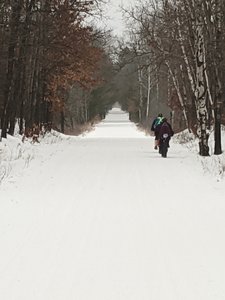 The Park Falls Gastropub was full of people who had decided to drop and a few people who hadn’t decided yet. I took too long again to refill my hydration pack and recharge my electronics. They had a delicious soup, but my stomach did not want to have anything to do with it, so my cup ended up wasted, but I did have some coffee to keep me going. I was still soaked and kind of tired of it to be honest, so I switched for a hard shell to try to stay a bit dryer on the way back. Every time I reached into a ziplock or a pannier, I dumped water into it and the softshell jacket I took off probably weighed an extra pound from rain. So much for keeping all my stuff dry.
The Park Falls Gastropub was full of people who had decided to drop and a few people who hadn’t decided yet. I took too long again to refill my hydration pack and recharge my electronics. They had a delicious soup, but my stomach did not want to have anything to do with it, so my cup ended up wasted, but I did have some coffee to keep me going. I was still soaked and kind of tired of it to be honest, so I switched for a hard shell to try to stay a bit dryer on the way back. Every time I reached into a ziplock or a pannier, I dumped water into it and the softshell jacket I took off probably weighed an extra pound from rain. So much for keeping all my stuff dry.
On the way out, I guess my stubbornness convinced a couple other people not to drop and four of us rode across the slick, icy streets of Park Falls, Wisconsin back to the eastern end of the Tuscobia trail.
At this point, the trail was absolute garbage. As the early morning went on, the number of times we fell through the crust increased. Eventually, the other three riders decided to take a left on a paved, ice-covered road, dropping from the race and making their way on more passable surfaces. But I checked my time and, even with the newly-reminded knowledge that checkpoing 3 closed at 10:00 AM, math told me I just had to do 3 MPH for the next 9 hours to make it.
Three hours later, I had gone 10 miles. Now I had to average 3.5 MPH.
Three hours later, I had gone 8 more miles. Now I had to average 4 MPH.
The next two hours, I only went a mile each. 5 MPH became 10 MPH...
I’m not going to make it.
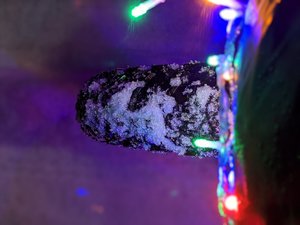 This is when the logistics of winter ultras became my foremost obsessive thoughts. Checkpoint deadlines should never be considered as goals. If you’re getting to a checkpoint as it closes, you’re probably in trouble. Of course, I considered this when planning my time for the race. But I was too stuck on my Arrowhead time being less than the available time to think much about the checkpoint deadlines themselves and completely missed that checkpoint 3 closed 13 hours before then end of the race but only 10 hours after checkpoint 2.
This is when the logistics of winter ultras became my foremost obsessive thoughts. Checkpoint deadlines should never be considered as goals. If you’re getting to a checkpoint as it closes, you’re probably in trouble. Of course, I considered this when planning my time for the race. But I was too stuck on my Arrowhead time being less than the available time to think much about the checkpoint deadlines themselves and completely missed that checkpoint 3 closed 13 hours before then end of the race but only 10 hours after checkpoint 2.
As I hiked my bike, postholing with every 3rd step, I thought about how the fast racers have completely different events than I do. At the Arrowhead, I was out in -35˚F weather well after the winner (and newly minted course record-holder) had finished in a relatively balmy -20. This morning, the winner of the Tuscobia had finished the day before, with a relatively passable trail, not this delicate surface of iced-over mashed potatoes.
At one point, there was a section of trail that was obviously saturated by rain. I had already had some experience with the deep snow in the gutters really being slush with some snow over the top, and I knew there was no way to ride over it, so I hopped off my bike and carefully chose a path that looked the driest. I was wrong. That path was also slush with some snow over the top. Oh well, my boots were already soaked through (they took days to dry out).
About 9:30 AM, with another 10 miles to go to checkpoint 3 and 101 miles into the 160-mile race, I got picked up by a snowmobile. We strapped my bike into a sled pulled behind and made several stops to make sure nothing was too loose. On the way, I learned there were many sections of trail with standing water on them and was kind of glad to not be trying to ride through them, even if it meant my race was over. We arrived safely at the checkpoint, my bike with a significantly more scratched up steer tube, as it officially closed but nobody had been through in a while. Everything was pretty much packed up.
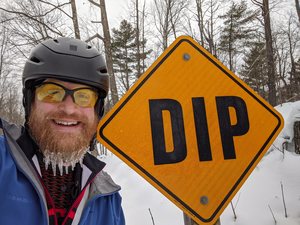 Later, at the hotel, I took a long hot shower, once again forgetting to turn on the fan with the pleasant sign above the switch warning that the fire alarm may go off due to steam (narrator: it never did). Lying on the bed, checking up on social media, I fell asleep at about 4:00 in the afternoon, 36 hours after I had woken up the previous day. When I woke up at 8:00 in the morning, I felt pretty well rested and super hungry. Luckily the hotel breakfast was still going on and I made good use of the waffle maker. This is when I noticed the tips of the middle two fingers of my left hand were slightly numb. Oddly, the same thing happened to the same two fingers of my right hand after the Arrowhead; it eventually went away. Is something wrong with my bike fit? Why didn’t I notice it the day before?
Later, at the hotel, I took a long hot shower, once again forgetting to turn on the fan with the pleasant sign above the switch warning that the fire alarm may go off due to steam (narrator: it never did). Lying on the bed, checking up on social media, I fell asleep at about 4:00 in the afternoon, 36 hours after I had woken up the previous day. When I woke up at 8:00 in the morning, I felt pretty well rested and super hungry. Luckily the hotel breakfast was still going on and I made good use of the waffle maker. This is when I noticed the tips of the middle two fingers of my left hand were slightly numb. Oddly, the same thing happened to the same two fingers of my right hand after the Arrowhead; it eventually went away. Is something wrong with my bike fit? Why didn’t I notice it the day before?
What did I learn?
- I pack too much and need to lighten my load. I can’t eat everything I bring and more weight in the back just makes me more likely to fall through the trail.
- Start with a hard shell if it’s raining. Even though my wicking system kept my base layer dry, I didn’t need the extra weight or the reduced insulation of wet layers.
- There’s always next year.
When I heard of the Arowhead 135, I thought "that sounds like a lot of fun!" and when I found out registration was open, I knew I wouldn't be accepted but I thought it would be good experience to go through the process. So I tackled that application with all the gusto of a medeocre white man.
Then I received the acceptance email...
Oh my, what have I done?
Somebody I knew in high school was posting some aikido stuff on their facebook page. It made me want to find some good videos of Tai Chi push-hands.
 There's a car ad, I think it's for Acura, where a guy is running down a trail through the woods when he sees a divergent path going straight up the hill, he takes it. Initially, I thought they were trying to show the runner as a risk-taking maverick character, a hardcore runner going for the challenge. That would have made a great ad for outdoor gear. The end of the commercial shows the runner reaching his car and talks about how buying a "pre-owned" vehicle is a great shortcut to getting what you "deserve."
There's a car ad, I think it's for Acura, where a guy is running down a trail through the woods when he sees a divergent path going straight up the hill, he takes it. Initially, I thought they were trying to show the runner as a risk-taking maverick character, a hardcore runner going for the challenge. That would have made a great ad for outdoor gear. The end of the commercial shows the runner reaching his car and talks about how buying a "pre-owned" vehicle is a great shortcut to getting what you "deserve."
Okay, fine, I get the buy-used line, but the guy is skimping on his morning run so he can get back to his car faster? He's probably just going to work now in order to pay off his car loan anyway. I'd rather stay outside for a while longer.
Earlier this summer, I saw a guy taking a shortcut to get to the running trail. You read that right. He was coming out of what I assume was his back yard, hopping a fence, crossing active railroad tracks, then hopping another fence to get to his run. To add silliness to potential injury, there's a road not 100 meters from his fence-jumping spot that crosses said tracks and trail.
Every time I see something like this, it really confuses me. The point of exercise is to get out and expend energy. You want to do more work in order to burn calories and fat and cause new calories and fat to be stored as muscle rather than fat reserves. Taking a shortcut can only short-circuit the whole concept of exercise.
Each day I ride, my goal is to come back a little sooner than I did last time. I don't do it by taking shortcuts, I do it by going a little faster. A few seconds less per mile each time, a minute or two less exercise each time. As I have extra time I add a few miles to my ride and start the cycle over again. A few seconds less...
Comics
AppleGeeks
The Awkward Yeti
Chainsawsuit [new!]
Ctrl+Alt+Del
Doghousediaries
Doonesbury
Formal Sweatpants
FoxTrot
Happle Tea [new!]
Hyperbole and a Half
Indexed
Joy of Tech
Kate or Die!
Lunarbaboon
Our Valued Customers
RealLife
Romantically Apocalyptic
Saturday Morning Breakfast Cereal
Scenes From A Multiverse [new!]
A Softer World
Sci-ence
Sinfest
Three Panel Soul
Wondermark
XKCD
Blogs
Almost Diamonds Antihero As I See It Black and WTF Caerwyn Farm and Spirits The Catty Life Domestic Sluttery Engrish For Goodness Sake Gizmodo Greg Laden Le Zèbre Bleu Lefse and Kimchee Lifehacker Light-test Linux in Exile Man Bytes Blog Photography is Not a Crime Post Secret Photoshop Disasters
Arts
New Pictures 8: Sarah Jones
Minneapolis Institue of Arts
04/18/2013—02/02/2014 - Free
31 Years: Gifts from Martin Weinstein
Minneapolis Institue of Arts
11/02/2013—08/31/2014 - Free
New Pictures 9: Rinko Kawauchi
Minneapolis Institue of Arts
02/20/2014—08/10/2014 - Free
Finland: Designed Environments
Minneapolis Institue of Arts
05/10/2014—08/17/2014 - Free
Music
Nick Cave and the Bad Seeds
at State Theatre
06/21/2014 \ Doors 8:00pm
Please wait while my tweets load
